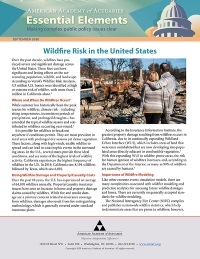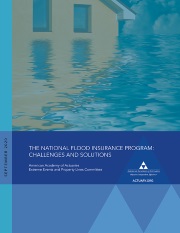Casualty Quarterly, Fall 2020
09/03/2020
 |
|
Fall 2020
VOL 4 | NO 3 |

XuLast year’s Wildfire: An Issue Paper—Lessons Learned from the 2017–2018 California Events looked at the issues stemming from following the California wildfires of the past few years that were among the largest and most costly on record. Also, the Academy released a new Essential Elements paper, Wildfire Risk in the United States. With another season of wildfires recently raging in the western part of the country, Casualty Quarterly did a Q&A with Jeri Xu, vice chairperson of the P/C Extreme Events and Property Lines Committee, about the issues involved.
You were one of the authors of last year’s issue paper, which noted, among other things, the complexity in modeling wildfire risk. The paper focused on California wildfires from 2017 and 2018—with the current fires that have been burning in Western states for almost a month, what are some of the applicable or practical lessons that have been learned since then?
With respect to wildfire modeling, we have seen major model updates as well as the emergence of new wildfire models in the past couple of years. The complexity of modeling wildfire risk is due to many factors, including the human influences on the cause of ignition, extent of mitigation, and impact of legislation and regulation, all of which are difficult to quantify. What we have learned is that models can capture only what we know. For example, before the 2017 and 2018 events, we did not fully understand the extent of the wildfire hazard, nor did we foresee the extent of legislative and regulatory impacts in the aftermath, and thus these factors were not incorporated into model assumptions. Now, on the prevention and mitigation front, utility companies are given more latitude to manage their transmission lines; local and state governments are more focused on wildfire preparedness and procuring the necessary funds. These positive impacts may not be fully factored into wildfire models yet. The landscape keeps evolving, which increases the complexity of modeling.
Are you seeing any new trends emerging—and related, is the committee planning to update the issue paper?
 Insurers and reinsurers view this peril completely differently now. Among natural catastrophes, wildfire was once treated as secondary to hurricane and earthquake, and an event as destructive as the Camp Fire was unimaginable. Now, the industry is more aware of the increased risk and is monitoring their exposure aggregations more carefully. Frequency and severity of wildfires can be affected by changes in climate risk factors. On a positive note, it is good to see the effort from the public and private sectors to prevent and mitigate wildfires. Generally, I think people are more aware of the peril after what occurred in 2017 and 2018. Given that 2020 has been an active wildfire season so far, we are considering an update of the issue paper with new learnings and experience, most likely after year-end data for 2020 becomes available.
Insurers and reinsurers view this peril completely differently now. Among natural catastrophes, wildfire was once treated as secondary to hurricane and earthquake, and an event as destructive as the Camp Fire was unimaginable. Now, the industry is more aware of the increased risk and is monitoring their exposure aggregations more carefully. Frequency and severity of wildfires can be affected by changes in climate risk factors. On a positive note, it is good to see the effort from the public and private sectors to prevent and mitigate wildfires. Generally, I think people are more aware of the peril after what occurred in 2017 and 2018. Given that 2020 has been an active wildfire season so far, we are considering an update of the issue paper with new learnings and experience, most likely after year-end data for 2020 becomes available.
What kind of response did the issue paper generate?
We were pleased with the level of interest from insurance and regulatory stakeholders. Our paper caught the attention of the National Association of Insurance Commissioners (NAIC) Catastrophe Risk (E) Subgroup. Last December, we were invited to speak at the NAIC Fall National Meeting, because the subgroup was considering adding additional perils, such as wildfire, into the RCAT risk-based capital (RBC) calculations. Several state insurance departments reached out for more information, and we also have pending requests from various actuarial groups to give talks and webinars.
The paper noted that some legislative and regulatory actions in California have made individual wildfire-related claims more expensive. Can you give us some examples? Is this increased exposure now reflected in higher property insurance rates?
One example is California SB 894, which extended the coverage for additional living expenses for an additional year, from 24 months to 36 months. Another example is California SB 917, which required coverage for losses resulting from a combination of perils (for example, mudslides) if the wildfire was a proximate cause. That legislation followed regulatory action that linked mudslides to earlier wildfires in the Santa Barbara area. These legislative and regulatory impacts are not easy to quantify, but directionally it is clear these measures extend coverage beyond the intent of the original insurance contract. Insurers also need to consider the uncertainty of what further legislation may arise after future events. Many personal lines carriers in California have filed for increased rates, but the rates are likely still not adequately aligned with the increased exposure.
How are the larger and more frequent wildfires in recent years related to our changing climate?
Climate risk factors reflect fluctuations in temperature and precipitation levels, among many other things. In recent years there have been observable warmer temperatures and more days of extreme heat. We are also seeing more variance in the amount of precipitation in different regions. For example, there can be periods of heavier rainfall that causes vegetation to grow, followed by periods of drought that causes the vegetation to dry out. This process provides more fuel for wildfires to spread. The Academy co-publishes an Actuaries Climate Index (ACI) that monitors such trends on a quarterly basis and, overall, the index points to a steady rise in extreme climate conditions.
You specialize in reinsurance. How is the reinsurance market adjusting to increased risk of catastrophic events—bigger and more frequent wildfires, more powerful hurricanes, rising sea level, etc.?
While every reinsurer has its own view of risk, we all need to account for the “known unknown” in our underwriting. Assessing natural catastrophe risk comes with a lot of uncertainty, and how changing climate risk factors impact various perils globally continues to be a challenging problem. Catastrophe modeling aids in the assessment of risk; however, the risk landscape continues to evolve, and certain aspects are hard to quantify. For reinsurers, it is important to find a balance between quantitative and qualitative assessments of risk. Effectively monitoring aggregate exposures is a critical part of portfolio and risk management.
Webinar Looks at Workers’ Comp and COVID-19

HeppenThe Academy hosted a webinar, “Workers’ Compensation: Impact of COVID-19,” on July 22 that followed the publication of the Workers’ Compensation Committee’s issue brief, Presumptive Benefits in Workers’ Compensation: Emerging Issues Before and After COVID-19.
Moderated by committee chairperson Dave Heppen, the speakers were committee members Derek Jones, Katrina Redelsheimer, and Doug Ryan. They covered the effects of unprecedented changes in the workforce, expansion of presumptive benefits for first responders and health care workers, consideration of the 2020 experience in the rate-filing process, and financial reporting issues, and answered many audience questions.
Ryan said that the coronavirus pandemic and related economic disruptions “have directly impacted and continue to impact the workers’ compensation system,” and noted that some of the changes have increased costs, while others have decreased them.
Redelsheimer said that funding of this unexpected liability—claims due to COVID-19—is not just an actuarial issue but also a public policy question. At least 20 states have changed their presumptive benefit laws to include COVID-19. On the other hand, she cited data showing that the severity of individual claims has been less than expected, with 82% of reported claims being for mild cases that did not require hospitalization.
Jones offered that, due to COVID-19’s direct and indirect effects, claims data from 2020 will look very different from other years. He reviewed a half a dozen ways that the pandemic is affecting non-virus claims. “Everything is affected,” he said.
Summing up, he observed that the various impacts of COVID-19 provide “a good example of how communications to our constituents becomes so important.”
Slides and audio are available for logged-in Academy members.
Academy Comments to NAIC on CASTF Predictive Models Exposure Draft
Academy Senior P/C Fellow Rich Gibson sent a letter to the NAIC in late July commenting on NAIC’s Casualty Actuarial and Statistical Task Force (CASTF) June exposure draft containing potential best practices for the Regulatory Review of Predictive Models (RRPM). The letter made several observations and cited Actuarial Standard of Practice (ASOP) No. 23, Data Quality.
“Model innovation has many potential benefits to the insurance market. At the same time, there is the potential for modeling to be stretched too far through such innovations. One would hope that application of the RRPM White Paper best practices, used effectively, finds a balance between innovation and control,” Gibson wrote.
COPLFR Paper Addresses Audit Committees and P/C Loss Reserve Expertise
The Committee on Property and Liability Financial Reporting (COPLFR) issued a new public policy paper, An Overview for P/C Insurers’ Audit Committees: Effective Use of Actuarial Loss Reserve Expertise. The document, which updates an earlier publication, is offered primarily for members of audit committees and boards of directors of P/C insurers subject to NAIC regulation.
The NAIC annually mandates requirements for loss reserve opinions. While most of the considerations apply as well to other insurance entities, including non-U.S. insurance companies, captive insurance companies, corporate self-insurers, etc., some of the references contained herein are specific to the NAIC’s requirements regarding the recording of loss reserves in insurers’ financial statements.
 The Actuaries Climate Index (ACI) continued a multiyear trend of increasing climate condition measurements from the United States and Canada, reaching a new high in winter 2019–20, according to the latest ACI quarterly data released Aug. 26.
The Actuaries Climate Index (ACI) continued a multiyear trend of increasing climate condition measurements from the United States and Canada, reaching a new high in winter 2019–20, according to the latest ACI quarterly data released Aug. 26.
The ACI’s key metric of a seasonal five-year moving average presents a composite measure of long-term changes across an array of observed weather extremes and sea levels in the two countries. It has steadily climbed from its most recent cyclical low of 0.70 in 2015 to a new high of 1.17 for the moving average in winter 2019–20.
Although the latest increase in the moving average is marginal, it is 0.07 above the previous winter and reflects that the extreme climate conditions tracked by the index—high and low temperatures, heavy rain, drought, high wind, and sea level—continue to move away from the reference period norms since inception in 1961.
“The ACI’s five-year moving average is a composite value reflecting the consistently growing change in measured values for the heavy rainfall, sea level, and extreme high and low temperature components that are fueling the overall trend toward extreme conditions seen in the latest data,” said Doug Collins, chair of the Climate Index Working Group. “While we should not expect the five-year average to always increase, if changes in climate indicators continue on their current course, the general trend in the ACI is likely to be upward.”
The ACI is sponsored by the Academy, the Canadian Institute of Actuaries, the Casualty Actuarial Society, and the Society of Actuaries.
Academy Highlights Hurricane Season, NFIP
 With several hurricanes causing widespread damage this summer and fall, the Academy called attention to the possible expiration of the National Flood Insurance Program (NFIP) ahead of the program’s authority running out on Sept. 30. (The NFIP was only just reauthorized for another year on Sept. 30.) The Academy highlighted reform options outlined the Academy’s June Essential Elements paper, “Plugging Holes in U.S. Flood Insurance” and the NFIP monograph originally released in 2017, The National Flood Insurance Program: Challenges and Solutions, which was just updated.
With several hurricanes causing widespread damage this summer and fall, the Academy called attention to the possible expiration of the National Flood Insurance Program (NFIP) ahead of the program’s authority running out on Sept. 30. (The NFIP was only just reauthorized for another year on Sept. 30.) The Academy highlighted reform options outlined the Academy’s June Essential Elements paper, “Plugging Holes in U.S. Flood Insurance” and the NFIP monograph originally released in 2017, The National Flood Insurance Program: Challenges and Solutions, which was just updated.
“An active hurricane season like the one that this year’s is shaping up to be brings flood risk to the forefront of many people’s minds, and ensuring that flood insurance remains available is vital,” said Academy Senior Casualty Fellow Rich Gibson. “Reauthorization of the NFIP offers an opportunity for Congress not only to extend the program, but also to consider reform options to expand coverage, better align the risks and costs of flood insurance, and address the NFIP’s debt and financing.” Read the Academy press release.
Congress passed, and the president signed into law, a one-year NFIP extension through Sept. 30, 2021. Read the Academy alert.
COPLFR Comments on Financial Examiners Handbook
The Committee on Property and Liability Financial Reporting (COPLFR) submitted comments to the NAIC’s Actuarial Opinion Working Group, suggesting changes to the wording in the Financial Examiners Handbook.
The comments related to the handbook’s items Nos. 1 and 3, including that part of item No. 3 is outdated.
Virtual Seminar on Effective P/C Loss Reserve Opinions
The Academy’s annual Seminar on Effective P/C Loss Reserve Opinions is coming to you virtually this year. The seminar, designed for your convenience and needs during these challenging times, will deepen your understanding of the latest requirements through reviews of actuarial qualification standards and case studies.
Seminar sessions—to be held on Dec. 9–10 and 14–15—will begin at 1 p.m. EST each of the four days and run through the afternoon. Each day will conclude with a Q&A session.
Seminar participants will have the option of registering for the entire program or for individual days, and group rates are also available. Continuing education (CE) credit will be available.
The agenda will cover:
- Dec. 9—A review of qualifications, responsibilities, record keeping, and practice notes.
- Dec. 10—A focus on reserve ranges and risk of material adverse deviation.
- Dec. 14—An overview of actuarial standards of practice (ASOPs) and a session on report writing.
- Dec. 15—A regulatory overview and an opinion writing workshop.
Mark your calendars and register today.
Register for the Virtual Annual Meeting and Public Policy Forum
![]() The Academy’s 2020 Annual Meeting and Public Policy Forum will be held virtually this year, on Nov. 5–6. It’s never been easier to attend—and now, it’s exceptionally cost-effective. We’ve lowered registration fees by 50% off the original in-person published rates for this year’s meeting. Daily and group registration rates are also available.
The Academy’s 2020 Annual Meeting and Public Policy Forum will be held virtually this year, on Nov. 5–6. It’s never been easier to attend—and now, it’s exceptionally cost-effective. We’ve lowered registration fees by 50% off the original in-person published rates for this year’s meeting. Daily and group registration rates are also available.
The two-day virtual event will feature topical keynote addresses that explore the results of the national election—held days before—and possible consequences: Day 1 will start with Charlie Cook of the Cook Political Report; Day 2 will start with noted presidential historian and author Michael Beschloss.
As always, the Annual Meeting includes practice-specific breakout sessions that offer depth and expertise not easily found elsewhere; plenary sessions that provide perspective on cross-practice issues and insights on top public policy and professionalism issues—and a chance to earn valuable continuing education (CE) credit, including professionalism CE credit. See the practice-area breakout session lineup, including P/C sessions, here.
You’ll have the opportunity to virtually celebrate this year’s recipients of the Academy’s 2020 service and volunteerism awards and the transition of Academy presidential leadership. This is your year to attend—register today and join us in November.
In This Issue
- Q&A—Wildfires
- Webinar Looks at Workers’ Comp and COVID-19
- Academy Comments to NAIC on CASTF Predictive Models Exposure Draft
- COPLFR Paper Addresses Audit Committees and P/C Loss Reserve Expertise
- ACI Continues Upward Trend
- Academy Highlights Hurricane Season, Looming NFIP Extension
- COPLFR Comments on Financial Examiners Handbook
- Virtual Seminar on Effective P/C Loss Reserve Opinions
- Going Virtual—Annual Meeting & Public Policy Forum
- Legislative/Regulatory Update
- In the News
Following is a roundup of state and federal P/C legislative and regulatory activity.
NFIP Reauthorization
The President signed following Senate passage of legislation that continues funding the federal government through mid-December, which includes a provision for a one-year extension of statutory authority for the National Flood Insurance Program (NFIP). Along with funding U.S. government operations, the legislation extends the NFIP, which was previously due to expire at the end of September, through Sept. 30, 2021. Read the Academy alert.
Commercial Insurance
Many affected small businesses were surprised to learn that most business interruption (BI) policies have an exclusion for viruses and other communicable diseases. More than 1,000 lawsuits challenging claims decisions based on those exclusions reportedly have been filed, but court decisions have generally denied those challenges. In at least half a dozen states, legislators proposed bills to create retroactive BI coverage related to the coronavirus pandemic, although none of the measures has progressed. Similar legislation also has made no progress in the U.S. Congress. In several states, governors and insurance regulators ordered insurers of restaurants and grocery stores to extend coverage to include off-premise food delivery (NJ A3844, NY A 10226, PA HB 2372, MA SD 2888, LA SB 477 AND HB 858).
Liability Shield Laws
In addition to federal and state laws that protect healthcare professionals from liability during periods of declared emergency, about 20 states enacted liability shield laws specifically to protect the operators of nursing homes. More broadly, at least half a dozen states have enacted liability shield laws to protect businesses generally from most COVID-19 liability claims brought by employees and/or customers (GA SB 359—also NC, OK, TN, UT, and WY). A similar measure to extend liability protection nationwide was contained in omnibus legislation that came before the U.S. Senate in September, but that legislation was voted down.
Automobile Insurance
In many states, bulletins were issued regarding automobile insurers extending personal automobile insurance policies to include coverage for personal vehicles being used to make deliveries of food and other essential items. Connecticut’s Bulletin IC-41 was typical of these. A number of states also addressed the question of how insurers should report rebates, dividends and other rate reductions related to sharp reductions in miles driven and accidents reported as people sheltered at home. The NAIC adopted guidance (INT 20-08) describing how premium refunds and other COVID-19-related adjustments should be handled for the purposes of statutory accounting.
Multiple states issued reminders that federal and state rules prohibit using credit scores in predictive models or other rating if an individual’s score was impaired as a result of the pandemic or other declared emergencies. Texas and Washington were among the first states to take this action.
Workers’ Compensation
Many states and some localities moved by legislation or regulation to extend workers’ compensation benefits to first responders who are affected by the coronavirus. In some cases, this presumption of benefits was extended to healthcare workers in general, and a few states also included workers in essential businesses such as grocery stores. The Academy’s Workers’ Compensation Committee recently published an issue brief discussing recent developments in presumption of benefits.
Wildfires
California lawmakers approved legislation that would make it easier for insurers to raise rates or pass through reinsurance surcharges related to wildfire exposure. The measures (AB 2167, SB 292) have been ordered to an “inactive file” and therefore have not been sent to the governor). The state did enact legislation that increases homeowners’ insurance payouts for additional living expenses during a state of emergency and simplifies the filing of claims for loss of personal property (CA SB 872).
Automobile—Telematics
In Louisiana, legislation was approved to allow insurers to give discounts to drivers who allow the installation of sensors and telematics devices in private passenger automobiles (LA HB 808, signed by the governor). Also, tort reform legislation had advanced, which would have reduced the cost of personal auto claims and litigation (LA HB9 and SB 418), but both were vetoed by the governor.
- Senior Casualty Fellow Rich Gibson discussed the challenges of insuring pandemic risk from an actuarial perspective in a subscriber-only Bisnow.com (Dallas) story on business interruption claims in the commercial real estate market.
- A report prepared for the Insurance Council of Australia on insuring pandemic risk cited the Academy’s June comment letter to the House Committee on Financial Services and Senate Committee on Banking, Housing and Urban Affairs.
- A subscriber-only A.M. Best article quoted Assistant Director for Research (Public Policy) Steve Jackson on the Academy’s analysis of the NAIC’s annual climate risk disclosure survey.
- A subscriber-only WorkCompCentral story cited the Academy’s June issue brief, Presumptive Benefits in Workers’ Compensation: Emerging Issues Before and After COVID-19. A separate WorkCompCentral column surveying state laws on compensability highlighted the issue brief.
- A subscriber-only WorkCompCentral article covered the Academy’s webinar, “Workers’ Compensation: Impact of COVID-19,” which discussed the effects of the unprecedented changes in the workforce due to the pandemic.
- Insurance Journal and subscriber-only Insurance ERM reported on the Actuaries Climate Index, jointly sponsored by the Academy and other actuarial organizations, which provides five-year average and seasonal measures of changes in extreme weather events and sea levels.
|
Copyright © 2020 American Academy of Actuaries. All Rights Reserved. |
 Phone: 202-223-8196
Phone: 202-223-8196